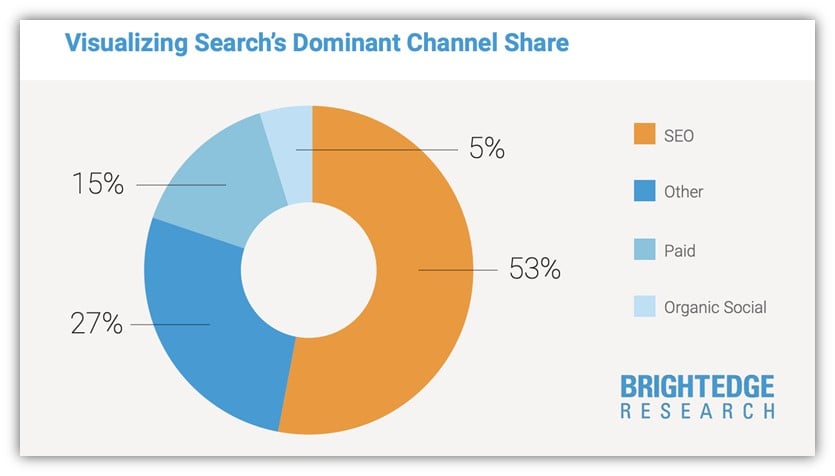All copywriting is trying to convey information and encourage action. Ads are persuading a click, pop-ups might be advertising an event or a content download, while ecommerce CTAs are guiding a shopper to look at a product. But your website copy, that will encourage your leads to become customers—as long as it’s effective.
Here, we’re sharing how website copywriting is different from other marketing channels, and then we’ll get to the tips to write copy that converts. Let’s get to it.
Contents
- What makes website copywriting different?
- Website copywriting tips (with examples!)
- Next steps: Master website copywriting
Because it’s all goal-oriented, there are a lot of similarities when you’re crafting copy for email, social, search, out-of-home advertising, and your website. But copy for each of these channels isn’t interchangeable. That’s why it’s important to know where your copy is going while you’re writing.
Here are a few ways website copywriting is distinct:
- Website visitors have limited attention spans, but you have a lot of information to include because this is your brand’s online presence.
- Your site has interactive elements, like buttons, navigation bars, and more. Many of these will require copy to guide your visitors through your site.
- SEO is important for your website to rank on search engines, which is where many of your visitors will find you.
- Your website visitors are your most diverse audience—more people will head to your website than sign up for your email or follow your brand on social.
- The ultimate goal of website copywriting is to get your visitors to convert.
Now, on to the tips for stronger website copywriting.
🖊 Get endless ideas for website copy that makes an impact using our free guide to 135 words and phrases for marketing with emotion.
If a visitor makes their way to your website, you want to make it easy for them to get the information that they came for. You also want to encourage them to engage further, learn more, and/or sign up for your newsletter or a demo. Here’s how to make that happen by writing copy that converts.
1. Know your audience
This is the most important step for crafting copy. You need to understand who you’re talking to in order to encourage any action. So before you start writing or refreshing website copy, spend some time reviewing your target customers. If you have them, read over your buyer personas to get a sense of both general demographics and motivations. If you don’t have those handy, take a look at your ideal customers. Consider their demographics like age, marital status, or job title, whatever might be relevant. Listen to recorded calls delving into their consideration process, motivation for buying, the biggest benefit of using your product or offering—or set up some time to ask your customers these questions.
Armed with this understanding of your audience, you can write to them directly. Leverage their motivations, speak to their problems, and maybe use a psychological effect in your copy.
But remember, this can look simple. Here’s a great example of copywriting that subtly communicates who the audience is from home compost tool Mill’s website.

By stressing the time to fill and promising to “lighten” garbage, this copy speaks to busy adults. Most of us, right? But then it gets more targeted.
The “trips to the curb” clearly applies to a home-owning suburban audience. This focuses on locations, living styles, and economic status with just a few words.
💡 Learn how to best connect with your audience using our free guide on 26 ways to use psychology in marketing.
2. Build your brand
When visitors hit your website, you want to supply them with all the information they need and make it easy for them to navigate deeper to higher-value pages. But while you’re doing that, you can also take the opportunity to make a memorable brand experience.
Your website color scheme and visuals will do a lot of this work, sure, but so will the accompanying copy. Here’s some inspiration from the trendy, fun prebiotic soda brand Poppi.

The neon colors and ’70s font is eye-catching, but the winks in the copy might just be the best part. The “but make it fashion” highlighting bright baggy sweatsuits that are all over Instagram is perfect. The punny “making pop history” even makes Shark Tank sound cool and youthful.
3. Understand your offering
One of my biggest marketing pet peeves is when I visit a website and can’t tell what the company does. Most of the time, it looks beautiful, sounds impressive, but that offering? Entirely unclear.
So when you’re writing website copy, make sure you know your offering inside and out. This will help you communicate it effectively to your audience—and avoid any frustrated visitors of your own.

Walden Meat is a local meat delivery service, which is totally clear based on their website copy above. Well done.
4. Stress the benefits
When you’re talking about your offering, you want the details to be there for prospective customers. But instead of wasting time and words on the features, talk about the benefits.
Features describe what your offering is, but benefits show how that helps your customer. Here’s an example from Mailchimp. The email platform’s feature is the AI-powered predictions referenced in the copy as “intelligent predictions.” The benefit is highlighted in the headline. With these predictions, Mailchimp will help your business get loyal, long-term customers.

This is an example of B2B marketing, but you can stress the benefits in your website copy regardless of your business type. Write out the features to highlight and then translate. And then, of course, take some time to revise until you get it right.
5. Get your headings right
The average time on page is 53 seconds, which means that people aren’t spending too much time reading your website copy. Instead, most are skimming over the copy as they scroll to find the information they’re looking for.
To work with this reality, you want to spend the most time getting the most high-value words right. Those words? Your headings. Take the time to make them clear, concise, and compelling. And be sure to read through the headings of your website only before finalizing.

The headings on Discover’s homepage get the idea across—even if you skip over the text below.
6. Limit your copy
In a class academic study of website user behavior, researchers found that users read about 20% of text on a webpage with 400 to 1,200 words, but up to 50% of text on a page with 200 words or fewer.
More text means less reading. The takeaway? Limit the copy on your website.
Zapier’s homepage is impressively brief without sacrificing information. Take a look at the hero section, with a compelling headline, key pricing details, and a signup CTA.

Even more impressive, this is the rest of Zapier’s home page.

Keeping it as compact as Zapier might not work for your homepage, but it’s a good practice. Cut where you can—it might even translate to more words read by your visitors.
7. Write strong CTAs
The goal of copywriting is to inspire the reader to act, whether it’s to download a guide, sign up for a newsletter, or purchase a product. Your calls to action, or CTAs, are the final push, and as such major opportunities to persuade readers.
Because we’re all on so many websites fielding tons of promotional emails, we’re seeing standard CTA language often enough to grow desensitized. Submit, Sign Up, Register Now, Start Your Free Trial, Schedule Now. These barely register.

Another example from Mill, but this one’s pretty meh.
Sometimes, dependable makes sense. But whenever you can, write a stronger CTA. The best way to do this is to get descriptive and specific.
8. Work with the UX
Don’t sleep on microcopy. These are the short phrases or words that guide visitors through your website, and they have the potential to inform, inspire, and even delight. Put them to work whenever you can.
Here’s a good, simple use of microcopy from Pexels, a library of stock photos and videos.

In the search bar, the copy reads “Search for free photos.” The free access is a key selling point of Pexels and a differentiator from its competitors. Sticking that into the search bar gets the point across one more time.
9. Bust out your thesaurus
There are over 1 billion websites, and every minute, 175 new ones are created. That’s a lot of noise. And with visual branding growing more and more similar, your copy is an underrated medium for differentiating your company’s website.
Remember, copywriting is a creative exercise. So take a look at your favorite ads for inspiration, draft and redraft, and bust out your thesaurus—or, uh, head to that website—to break out of your routine.
10. Optimize for SEO
Optimizing your website for SEO is imperative to ensure your brand is visible online. 68% of all online experiences begin with a search engine, and Google is the most used by far. So before you launch any copy changes, be sure to double-check on-page SEO best practices.

11. Use trust markers
Not all of your website visitors will be ready to convert. Some will check it out for the first time then return again and again before they’re ready to become a customer. For these visitors, you want to make the most of each visit to build trust in your brand.
Using common trust markers like reviews, awards, or key customers is a good way to do this. You can embed reviews from Google, or you can pull out some key phrases in your copy. You can even reference the company names or the aggregate numbers to highlight.

12. Use numbers
Numbers are a quick way to convey authority, especially when they’re big and specific. If you have the stats to leverage, get those figures into your copy. This could be the number of locations of your business, customers you’ve served, reviews you’ve received, projects you’ve finished, or even the number of products you’ve sold.

Instacart packs a ton of numbers into a short section on its homepage.
13. A/B test
A/B testing doesn’t actually stand for always be testing, but it’s a common, connected refrain that fits too perfectly not to use. A/B testing, or split testing, involves running two versions of a test subject simultaneously and tracking the performance of each version in order to determine a winner. For your copy, this could mean two different CTAs or headlines.
Your headlines in particular are worth testing. Chartbeat conducted a study of its users and found that websites consistently testing headlines drove more than 5X the engagement. Even if you’re not using that specific tool, it’s convincing.
Moral of the story? Always be copy-testing.
14. Prioritize mobile
In March 2024, 67% of web traffic was on mobile devices. If more than half of your website visitors are likely reading it on their phone, you should be writing the copy with this medium in mind.
What does that look like? Think about the length of words, the cut-off points, and the number of lines. Take a look at this example from Grammarly’s website.

This is the desktop version, and even this view looks a bit heavy. Three lines of a single heading stacked in bold on a phone screen? Worth an edit.
15. Make it accessible
Your website must be accessible. Most of this will be down to the website design, but there are still a number of ADA compliance standards for website copy.
Here’s a quick overview the Website Accessibility Initiative:
- Ensure your titles are unique and informative.
- Be mindful of your heading structure.
- Make sure you have descriptive alt text for any graphics.
- Create transcripts of any audio.
- Link descriptive text vs filler, like “See here.”
- Write clearly and concisely, especially with instructions.
16. Test out AI
There are tons of ways to use AI in marketing, and sourcing ideas for website copy is a solid one. Head to ChatGPT to get a dozen heading examples, find new ways to describe your offering, and more.
A time saver that might just yield better results is a win-win. Just be sure not to use AI-generated copy for your final product. That definitely needs an edit—which leads us to our final tip.
17. Don’t forget to edit
You need to edit your copy to catch any typos, grammar mistakes, incorrect spellings, errant capital letters, or any other minor issues. This might seem pedantic, but copy mistakes have business impacts. In fact, in a Tidio study, 97% of respondents said that grammar errors negatively impact their perception of a brand.

If you’re working quickly, self-editing can work. But it’s better to see if you can find someone with fresh eyes to read over your copy—ideally someone with a great eye for errors.
Your website is arguably your most important online presence, with the most real estate to build your brand, share information, and convert your customers. So it’s worth spending more time on your website copy, including drafting, revising, editing, and testing. Good luck!
For more help with your website copywriting and beyond, see how our solutions can help you better connect with your audience for both short and long-term success!
We covered a lot in this post, so here’s a quick recap of tips for better website copywriting:
- Know your audience
- Build your brand
- Understand your offering
- Stress the benefits
- Get your headings right
- Limit your copy
- Write strong CTAs
- Work with the UX
- Bust out your thesaurus
- Optimize for SEO
- Use trust markers
- Throw in some numbers
- A/B test
- Prioritize mobile
- Make it accessible
- Test out AI
- Don’t forget to edit








